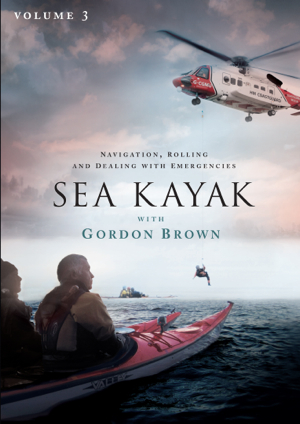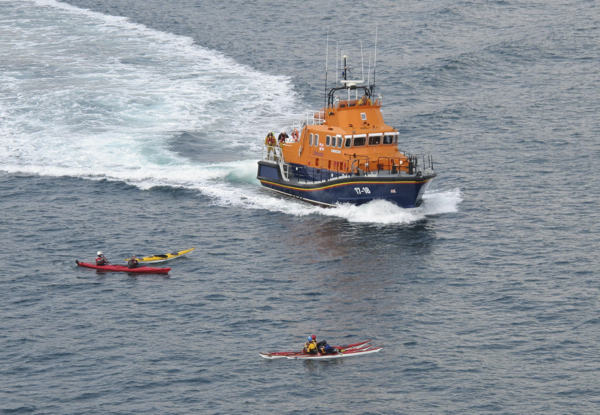Sea Kayak with Gordon Brown: Volume 3, a new DVD from Scottish sea kayak coach Gordon Brown, delves into three critical—yet often overlooked—elements of kayak safety and skills: navigation, first aid and dealing with emergency situations.
Following up on the success of Sea Kayak with Gordon Brown, the award-winning debut effort of Brown and producer Simon Willis, the pair released a follow-up film in 2011 that focused on teaching rescue techniques. With Volume 3, Brown and Willis explore some engrossing new territory for a kayak instructional DVD.
We asked the team about the challenges of producing a film that features, among other things, behind-the-scenes footage of actual Coast Guard air and sea rescues in progress.

There are a few hairy moments in this film—the parachute flare incident comes to mind… what were the biggest challenges of producing the rescues portion of the DVD?
SW: Daring to believe we could make such an ambitious film that required the loan of a Coast Guard rescue helicopter and two RNLI lifeboats. How do you ask a government authority, “Can I borrow a chopper please?” No one had attempted an instructional film like this before, so I couldn’t tell them “it’ll look like this.” Nor could I show them a script, because everything in the film came later after talking to the experts and learning how they conduct different rescues in different situations and conditions. Where there were no official protocols, Gordon worked with the different crews to develop the best way for them to deal with sea paddlers. They literally were making it up as they went along – I just filmed it.
Once we started the main block of filming, my biggest challenge was the weather. It was too good! We decided to film off Scotland’s Outer Hebrides in February because we wanted challenging conditions, but a high pressure weather system settled overhead for a whole week. The light was fantastic, but zero wind meant our helicopter could only carry out winch rescues in genuine emergencies, not in training situations and definitely not when filming. Fortunately the weather returned to normal within two weeks and we returned to get the shots we needed, albeit with a different winch-man and winch operator. If you look carefully, the crew inside the helicopter appears to change clothes part way through the sequence.
GB: When we decided that we wanted to do some live flare firing from the kayak, it was pretty easy to get the permissions necessary from the Coast Guard, provided we used a white parachute flare. The parachute flare or rocket was quite a surprise. I have let off quite a few of these over the years on land in a practice situation, but the thought now of letting one off whilst in a kayak makes me shiver. I can still remember the feeling of the ‘thump’ on the heel of my hand as it went off. I’ve kept the empty tube as a reminder, too.
What was it like to actually put yourself in the position of needing a Coast Guard rescue?
SW: At no stage did any of our kayakers genuinely need a rescue. We were prepared for the professionals to be called away to a genuine emergency at any moment. They wouldn’t wait for us! When Gordon and Andy appear to be floating alone without paddles, both have four-section Werner paddles stowed in their hatches and there are two other paddlers filming them with tow lines and a back-up VHF. Everyone involved was an experienced paddler who could take care of him or herself, but we took no chances.
GB: I have yet to put myself in the position of needing the professionals to help me. I am now quite confident that by working with these fantastic people, I will be able to help myself if, or when, it does happen. I hope that people who watch the DVD will get a similar amount of useful information.
Did you learn any new skills or tactics—or debunk any common misconceptions—while producing this film?
GB: The direction finding capabilities of both helicopter and lifeboat makes it absolutely necessary to carry a VHF radio. The fact that a pinpoint red flare is more easily seen [than an orange smoke flare] was an eye opener. I also learned that it is almost impossible, when you are below a rescue chopper, not to look up in awe. The noise, the spray the precision of the crew all make you just want to watch and enjoy.
SW: As a sea kayaker myself, I’ve changed what kit I carry as a result of working with the professionals. The film’s aim is to share the insight into how the emergency teams work, allowing you to decide what to carry for the kayaking you do.
I also learnt I can lean right out of a helicopter with a camera on my shoulder and not be terrified! Don’t laugh – I went two days early to the Outer Hebrides so I could practice filming with fresh air below my feet because I expected to be terrified. However, once my eye was to the viewfinder I was seeing everything on TV and was relaxed.

Sea Kayak with Gordon Brown, Volume 1 and 2 use a unique platform of an instructional journey to teach the skills, whether they be kayak handling or navigation. Tell me about how you developed this format. Why does it work well for teaching sea kayak skills?
SW: Usually Gordon handles the kayaking and I handle the filming, but occasionally there is an inspired cross-over of ideas. Our format of combining a journey with coaching was entirely Gordon’s idea and one he devised right at the start. Gordon coaches sea kayaking within the context of a journey so he felt the films ought to operate in the same way. It was up to me to make it all work.
From the filmmaking viewpoint it delivers a secondary benefit. Some instructional DVDs are so jammed full of non-stop coaching they become too intense and overpowering to watch. There’s only so much information your brain can absorb before the additional facts start running out of your ears. Breaking up the instruction with a spectacular journey not only is a feast for the eyes, it gives the viewers time to digest what they’ve learnt and prepare themselves for the next lesson. Actually, it works in a similar way to one of Gordon’s real-life coaching sessions.
Against the advice of our executive producer, we tore ourselves away from this format for Volume 3. There were several reasons, the main one being that the topics we wanted to coach were too diverse to fit around one film. That said, the Emergency Situations, Sea Kayak Navigation and First Aid Kits films [in Volume 3] are proper, stand-alone films, each with a well thought out structure.
Who do you think will enjoy this DVD?
SW: Emergency Situations is the sort of show I’d have made when I worked for the BBC, so I think it will appeal to anyone, whether they kayak or not. Advanced paddlers will pick up lots of coaching tips from the way Franco Ferrero coaches navigation, Rowland Woollven coaches first aid and Gordon coaches… well, everything.
GB: I think that most people who enjoy a bit of excitement will enjoy the main film, more so if they are ever likely to need the help of the rescue services. The others are more suited to kayakers, but with the exception of the Rolling Clinic all work with anyone who is in the outdoors.
Any plans for a Volume 4?
SW: At this stage in each production I say, “Never again.” Yet two years later we launch a new DVD. So anything I say now will probably be wrong.
GB: If we were to make [another film], I think we would have to change our approach. I don’t coach the same thing twice the same way. Simon works out the tech stuff to allow us to film what hasn’t been done before and I guess that it’s down to me to come up with another hair-brained, half-cooked idea that is impossible to do, worse than impossible to film and ridiculous to make work as a coaching film, then he’ll work his magic.
To learn more, access free downloads or purchase a film, visit www.seakayakwithgordonbrown.com.
This article appeared in Paddling Magazine, December 2013. Download our free iPad/iPhone/iPod Touch App or Android App or read it here.



